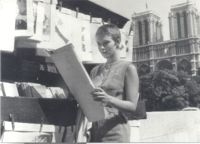|
FEBRUAR
|
|
2002
|
|
Rubriken |
|
Service |
|
Kontakt |
|
Nouvelle
Vague: "Außer Atem"
|
||||
 |
|
|||
|
Der Kleinganove Michel Poiccard stiehlt in Marseille ein Auto. Auf der Flucht erschießt er einen Polizisten. Er fährt nach Paris, versteckt sich bei seiner Freundin, der amerikanischen Studentin Patricia Franchini, und versucht, sie zu überreden, mit ihm nach Italien zu gehen. Die Polizei ist ihm bereits auf der Spur. Patricia wird mit der Ausweisung nach Amerika bedroht. Sie verrät Michel, will ihn aber im letzten Moment noch warnen. Sie kommt zu spät. Er wird auf der Flucht erschossen. „Außer Atem“ war der erste und der typischste Film der „nouvelle vague“. Die Hauptakteure, der französischen Kinorevolution waren an den Dreharbeiten beteiligt: Jean-Luc Godard führte Regie und verfaßte zusammen mit FranVois Truffaut das Drehbuch, Claude Chabrol wählte die Schauplätze aus. Die Gruppe junger Regisseure, alle ehemalige Redakteure der Zeitschrift „Cahiers du Cinéma“, formierte sich in den 50er Jahren und stellte stilistische Regeln auf, die damals so revolutionär waren wie die „Dogma“-Regeln heute: Originalschauplätze, nur natürliches Licht, ein Minimum an technischer Ausstattung, authentische Dialoge, Geschichten, die den Erfahrungen des Regisseurs und des Drehbuchautors entsprechen – und eine absolute Ablehnung von Historien- und Ausstattungsfilmen. Stilistisch orientierten sich die jungen Wilden an Giganten wie Hawks, Huston und Hitchcock, nahmen aber auch Elemente der amerikanischen B-Movies auf, indem sie absichtlich harte Schnitte und zu starke Kontraste betonten. „Außer Atem“ wurde in nur vier Wochen in den Straßen von Paris und in billigen Wohnungen gedreht. Der Schauspieldebütant Jean-Paul Belmondo avancierte mit der Rolle des Michel, gleichzeitig eine Huldigung und eine Parodie des „Bogartian Man“, zum Superstar des französischen Kinos. Jean Sebergs Patricia wurde eine Modeikone und eine Kultfigur – die einzige Rolle, die der charmanten Amerikanerin zu bleibendem Ruhm verhalf. vh |
||||
|
Breathless
|
||||
|
Small-time crook Michel Poiccard steals a car in Marseille. Fleeing from the police, he shoots a cop. He goes to Paris where he hides at his girlfriend’s place and tries to convince her to go to Italy with him. The police is already after him. His girlfriend Patricia, an American student, is threatened with expulsion to the United States. She betrays Michel, but wants to warn him at the last moment. Too late – Michel is shot on the run. “Breathless” was the first and the most typical film of the French “New Wave”. The main representatives of that French movie revolution were involved in the making: Jean-Luc Godard directed and wrote the screenplay in co-operation with Francois Truffaut, Claude Chabrol chose the setting. The group of young directors, all of them former authors of the magazine “Cahiers du Cinéma”, amalgamated in the 1950s and established stylistic standards which where then as revolutionary as the “dogma” rules today: authentic settings, only natural light, a minimum of technical equipment, authentic dialogues, plots corresponding to the director’s and the author’s experiences – and an absolute rejection of historical and costume films. Stylistically, the young rebels followed giants like Hawks, Huston and Hitchcock, but also took over some elements of the American B-movies accentuating improper cutting and sharp contrasts. The shooting of “Breathless” in the streets of Paris and in cheap apartments took only four weeks. Jean-Paul Belmondo playing his first part as Michel, both a tribute to and a parody on the “Bogartian Man”, was promoted French super-star. Jean Seberg’s Patricia became a fashion icon and a cult figure – the only part that earned the charming American actress lasting fame. vh |
||||